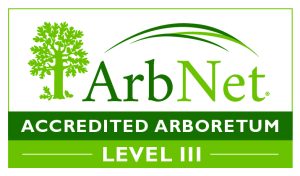Hoyt Arboretum is Portland’s museum of living trees and, like any museum, there’s a curatorial process behind its layout. Home to over 6,000 trees—with more than 2,300 species from over 170 families, including 67 species listed as rare or endangered—Hoyt Arboretum is a world-class collection actively promoting conservation, education, research, and recreation. The collection is tailored to support those goals.
Design by Taxonomy
Our living collections serve the public and educational and scientific communities by providing a living exhibition of global tree diversity. The majority of the Arboretum is arranged according to phylogeny—meaning that plants that share common evolutionary ancestors are grouped together. (The exception to this is the Bristlecone Pine Trail, where trees are grouped geographically according to their country of origin.)
Our collections were first planned and organized in 1930 by horticulturalist and landscape designer John W. Duncan. The Duncan Plan hangs in the Bill deWeese Classroom, and it still serves as the foundation to our collections. Many of our trees date to those very earliest plantings and can still be located using the Duncan Plan.
Nationally-Recognized Collections and Partnerships
As a member of Botanic Gardens Conservation International, one of our primary goals is the conservation of rare and endangered species. Maintaining a species here in the Arboretum that is endangered or has been extirpated in the wild is known as ex situ or “off-site” conservation and serves as a reserve of wild genetic diversity. These plants can then provide fertile material like seeds or clones that can be used to restore habitats and reestablish native populations.
Originally established as a conifer arboretum, Hoyt’s collections of redwood, spruce, pine, fir, and cedar have grown to impressive heights. Our Conifer Collection is an American Conifer Society reference garden thanks to its diversity, rare and endangered species, and many notable trees, including the first dawn redwood to set cones in North America in 6 million years.
Magnolia and Maple trees thrive in the Pacific Northwest, and our collections reflect that vitality. Over 60 cultivars and species of magnolia burst into blossom here, and the Maple Collection blazes with the colors of over 90 species, subspecies, and cultivars in autumn. Both are accredited by the Plant Collections Network of the American Public Gardens Association, which recognizes the quality and breadth of the collections, the garden’s long-term commitment, a favorable local environment, and institutional expertise.
Hoyt Arboretum is recognized as a Level III arboretum by the ArbNet Arboretum Accreditation Program.


Level III arboreta have at least 500 species of woody plants, employ a collections curator, have substantial educational programming, collaborate with other arboreta, publicize their collections, and actively participate in tree science and conservation.
Collections Policy
In response to advancements in horticultural practices and botanical understanding, we revised our plan and collections policy to establish the Family Plan in 2002. The discovery of new plant species, horticultural advancements showing additional species to be hardy in our climate, and climate change have greatly increased the number of species we can grow.
To be considered for inclusion in our collection, all trees must be grown from seeds collected in the wild that have proven provenance (a record of their geographic origin). Exceptions can be made for rare or unusual cultivars, or when a wild seed will take an inordinate amount of time to mature and a mature tree is immediately available. Visitors will still find several horticultural cultivars that have been in the collection since before the Family Plan was established.
Herbarium
The Hoyt Arboretum Herbarium (HAH) is a reference library of pressed and dried plants, whose primary purpose is to scientifically authenticate and archive the Arboretum’s internationally-recognized tree collection. The herbarium also houses specimens from Portland natural areas, emphasizing the documentation of regionally-significant native and non-native plants. The herbarium is open by appointment.
Plant Database
Our Garden Explorer plant database contains entries for over 6,300 trees, shrubs, and plants growing in the Arboretum or archived in the herbarium. The database contains information on each specimen including Latin and common names, cultivar, provenance, specific location, and select photos.
Bill deWeese Library
Visitors are welcome to peruse our 800-title horticultural library in the Bill deWeese Classroom during Visitor Center hours if it’s not being used for an event. From historic taxonomy to cultivation references to foraging guides, the library contains a wealth of botanical knowledge for the professional horticulturist and the botanical enthusiast alike.
